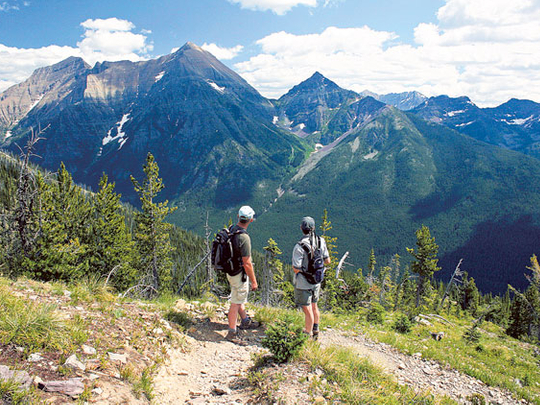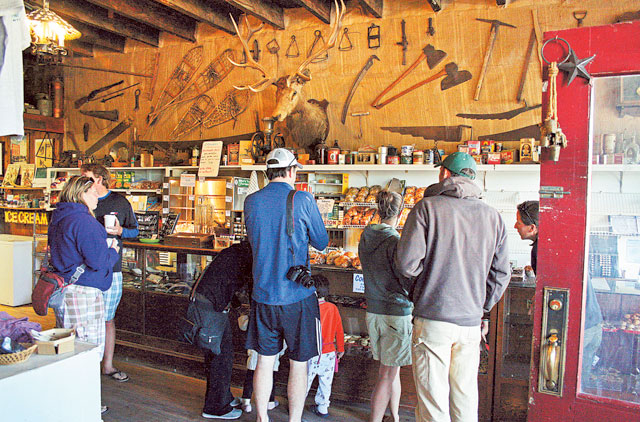
The Blackfeet tribe named the greater Glacier National Park ecosystem “the backbone of the world”. Use the park’s remote, northwestern entrance, and the bumpy access road will have you feeling like you drove over each vertebra.
But you’ll be grateful you made the trip.
For an out-of-the-mainstream take on America’s tenth national park, go to its northwestern expanse, the North Fork. It invites “a more self-reliant visitor”, the National Park Service says in its glacier literature.
The North Fork doesn’t have the grand old lodges, such as those near Glacier’s principal gateways, but this piece of paradise isn’t without comforts. Rustic, marvellously tasty and memorable, they are in Polebridge, about 1.6 kilometres from the park’s northwestern entrance. This off-the-grid community increasingly reliant on solar power is the hub for an area where the summer population numbers may be a few hundred, up from five to ten in the winter.
Get a cabin, stay in a hostel or overnight in a teepee. At the Northern Lights Saloon, bite into burgers — choose beef or elk — or try specials such as trout with dill sauce. Next door at the Polebridge Mercantile, bakers daily turn out bread, cookies, brownies and cinnamon rolls that would draw customers anywhere, but seem doubly delicious in an outpost such as this.
People find their way to the North Fork for hikes in the spectacular wilds of the Northern Rockies, to relax on water and to camp.
“Glacier park is world-renowned as a wilderness park, and the wildest part of Glacier is the North Fork,” says Will Hammerquist, Glacier programme manager for the National Parks Conservation Association. “You can feel the wilderness around you. That’s a big part of why people go there.”
Camping in the backcountry requires permits from the National Park Service. The places for car camping are next to alpine lakes. Guides take rafters through the relatively mild rapids of the North Fork of the Flathead River, and the hiking trails cross kilometres of rugged land. Like the trails elsewhere in Glacier, they are in grizzly-bear habitat. The park service’s recommended precautions include not hiking alone.
Remote though this part of Glacier is, it can be a destination for either a day trip or a longer visit.
With a morning departure from the town of Columbia Falls, you can travel the 56 kilometres to Polebridge, about a third of it on an unpaved road, then drive about ten kilometres on a road rougher than the first (but still manageable in a sedan) and arrive at Glacier’s Bowman Lake with a big chunk of the day remaining. The crystalline lake 10.5 kilometres long draws campers, anglers and people with kayaks, canoes and stand-up paddleboards, equipment available for rent in Polebridge. The lake is also the starting point for some of the North Fork hikes.
If you want to trek for just the day and return to Polebridge in time for dinner at the Northern Lights Saloon, consider going to the Numa Ridge Fire Lookout. The round trip covers 16.9 kilometres. If that’s too much, go just part of the way. There’s no shortage of splendour.
The route starting at the southwestern end of Bowman Lake begins with a relatively easy path through the forest. The last third of the trip has switchbacks to the lookout, which is at 2,121 metres and is staffed. Sit among the wildflowers near its base, dig into food brought from the Merc, take in the fabulous views of snow-crowned peaks and catch the shimmer of the glacier-fed lakes far below.
For the hardy with more time, backpacking in the North Fork can be an international experience. Drive the 24 kilometres from Polebridge to Kintla Lake, hike 51.5 kilometres to Goat Haunt and cross into Canada’s Waterton Lakes National Park, either on foot or on a Waterton Shoreline Cruise Co boat, being sure to carry a passport or other government-issued ID acceptable at the border. Together, the parks in Alberta and Montana comprise Waterton Glacier International Peace Park, a Unesco World Heritage Site.
The North Fork has high-elevation and low-elevation trails, with those at the upper elevations ordinarily most accessible between the Fourth of July and Labor Day. For the other trails, add a few weeks on each end.
If hiking, canoeing or river rafting aren’t what you want in a national-park vacation, the North Fork still accommodates. Camping at Bowman and Kintla lakes is relaxing, a chance to simply take in the scenery and maybe see some wildlife.
On the human creativity end of the spectrum, there’s Independence Day in Polebridge. Holiday revellers pour in for live music, grilled fare and a parade with casts of characters that have included Uncle Sam and Santa Claus.
Many of the people who go to Glacier in the summer see it only through a windshield as they travel Going-to-the-Sun Road, the winding, 80-kilometre blacktop through forests, past sweeping alpine expanses, along the shores of glacial lakes and over the Continental Divide at 6,646 feet. That experience alone is worth visiting the park. But for those wanting to unwrap the gifts of Glacier and environs differently, the North Fork is hard to beat.
— AP








